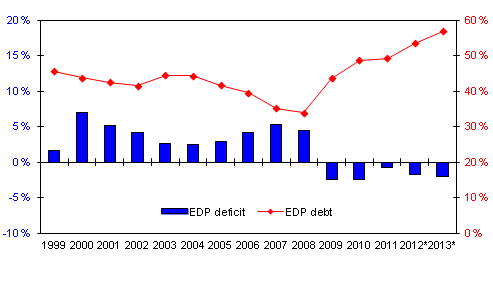Published: 3 March 2014
General government deficit 2 per cent and debt 56.9 per cent relative to GDP in 2013
According to Statistics Finland's initial preliminary data, during 2013 Finland's general government consolidated gross debt grew by EUR 7 billion to EUR 110.2 billion. The GDP share of the debt rose from the previous year’s 53.6 per cent to 56.9 per cent. General government deficit relative to GDP went up to 2.0 per cent from the previous year's 1.8 per cent. According to the preliminary data, public deficit and debt remained below the reference values of the European Union’s Growth and Stability Pact.
Finland's general government deficit (-) and debt, percentage of GDP

In 2013, the financial position of general government was EUR 3.9 billion in deficit. The central government sector's deficit remained almost unchanged, being EUR 6.5 billion. The local government sector's deficit decreased by EUR 0.7 billion to EUR 1.5 billion. This was caused by tax revenues increasing and growth of expenditure slowing down. Employment pension funds and other social security funds accumulated a surplus of EUR 4.1 billion, which was EUR 1.1 billion lower than in 2012. This was mainly affected by pensions paid growing more than pension income.
In 2013, general government’s unconsolidated gross debt increased by EUR 7.2 billion from the year before. Central government debt rose by EUR 5 billion whereas local government debt grew by EUR 2.2 billion. Internal general government debt increased by EUR 0.2 billion. The EDP debt describes general government’s debt to the other sectors of the economy and to the rest of the world, and its development is influenced by changes in both the unconsolidated gross debt and the internal general government debt. The EDP debt of the central government sector was slightly revised for the years 2009 to 2012 due to the instructions issued by Eurostat to record deposits of the European Commission as deposit debts. Previously they were recorded in the item of other accounts payable, which is not included in the EDP debt.
In general government accounts, the European Financial Stability Facility EFSF is, based on Eurostat's decision, handled so that the EFSF's borrowing is recorded as part of the gross government debt of the countries that have provided guarantees. The loan received by the beneficiary country from the EFSF is recorded as if it had been received from the countries in the euro area that have provided guarantees, and these countries in turn owe the corresponding amount to the EFSF. As a result, the EDP gross debt of the countries that provided guarantees grows but the net debt remains unchanged because the countries have a similar receivable from the beneficiary country. The gross government debt to be recorded for each country on the loans granted by the EFSF is calculated by dividing the loan granted to the beneficiary country by the contribution key (based on the share in the ECB's capital of each country participating in the support operations).
For 2013, EUR 3426 million has been recorded as debt granted by the EFSF to beneficiary countries in Finland's general government debt, while the amount at the end of 2012 was EUR 2702 million. No corresponding handling is made in the case of the European Stability Mechanism (ESM).
The public deficit concept used in these statistics complies with the Excessive Deficit Procedure (EDP) of the European Union's Growth and Stability Pact. This so-called EDP deficit corresponds with the net lending of the general government sector account in national accounts (ESA95), except for the interest flows relating to swap and forward rate agreements, which are entered as interest expenses in the EDP deficit report but as changes in derivative debt in national accounts. In 2013, the impact from the difference between the methods amounted to 0.3 per cent of GDP, and according to preliminary data, the net lending of the sector accounts compliant with ESA95 was -2.4 per cent of GDP.
The EDP debt of general government differs conceptionally to some extent, for example in the case of central government, from the central government debt published by the State Treasury. Central government's EDP debt includes loans granted to beneficiary counties by the European Financial Stability Facility EFSF (as explained above), received cash collaterals related to derivative contracts, the capital of the Nuclear Waste Management Fund, debts generated from investments in central government's PPP (public-private partnership) projects, and coins that are in circulation. In national accounts, central government is also a broader concept than the budget economy, in addition to which it includes, for example, universities, Solidium and Yleisradio (Finnish Broadcasting Company). When these differences are taken into consideration we reach central government non-consolidated gross debt in accordance with the EDP concept (Appendix table 3), i.e. in 2013, the State Treasury's central government debt EUR 89.7 billion + conceptual differences of the debt EUR 9 billion + differences caused by the sector delimitation EUR 0.7 billion = central government non-consolidated gross debt EUR 99.4 billion. The valuation principle for both debt concepts is the nominal value, where the effect of currency swaps is taken into account.
The next release from these statistics will be made on 31 March 2014 when Statistics Finland will publish the deficit and debt report compiled in accordance with the Excessive Deficit Procedure (EDP), which must be submitted to the European Commission at the end of March. The data published here may become revised in that connection.
Source: General government deficit and debt. Statistics Finland
Inquiries: Mira Lehmuskoski 09 1734 2708, Jukka Hytönen 09 1734 3484, financial.accounts@stat.fi
Director in charge: Leena Storgårds
Publication in pdf-format (256.5 kB)
- Tables
-
Tables in databases
Pick the data you need into tables, view the data as graphs, or download the data for your use.
Appendix tables
- Revisions in these statistics
-
- Revisions in these statistics (3.3.2014)
Updated 3.3.2014
Official Statistics of Finland (OSF):
General government deficit and debt [e-publication].
ISSN=1799-5914. 2013. Helsinki: Statistics Finland [referred: 25.12.2025].
Access method: http://stat.fi/til/jali/2013/jali_2013_2014-03-03_tie_001_en.html

